Farm & Ranch
From ‘Fitbits’ to Bioenergy Recovery – Rethinking today’s dairy farming

By Cecilia Jacobs
Robotic milkers. Automated feeders. Inline parlor technologies. They all make dairy operations, whatever the size, more efficient.
Researchers at Tarleton State University’s Southwest Regional Dairy Center are exploring more new gadgets and concepts sure to change the way milk producers manage their herds and farms. From bovine accelerometers (think Fitbit) to a closed-loop system that reuses wastewater and powers itself on manure, Texas’ only operational teaching and research dairy is rethinking best practices to improve farm profitability, milk quality and animal welfare.
Here’s a look.
Precision Dairy Cattle Monitoring
Equipping cows with smart, wearable fitness sensors—called accelerometers—to monitor everything from estrus to illness in individual animals is the latest craze in dairy technology. Similar to Fitbits, these relatively new gadgets monitor physical movement, body temperature and reticulorumen pH along with feeding, lying and rumination times. “Identifying changes in activity, especially in time spent eating and ruminating, can help identity illness and disease before they’re obvious to farmers,” explains Barbara Jones, director of the Southwest Regional Dairy Center in Stephenville, Texas. “Discovering sick and lame cows sooner improves treatment success, reduces loss and increases longevity and overall animal well-being.
“The benefit of catching cows in heat with limited human observation or pharmaceutical intervention is an added cost savings,” she says, “allowing farmers to identify optimum times for insemination.”
All 300 to 400 cows at the Southwest Regional Dairy Center sport accelerometers that continuously transmit information to a computer equipped with software that mathematically examines the data from each animal relative to her baseline. Generally worn around the neck or leg of the cow, or attached to the ear, accelerometers capture information in real time. Herd managers determine how often to collect and review the data.
To read more pick up a copy of the July 2017 NTFR issue. To subscribe call 940-872-5922.

Dr. Eunsung Kan’s concept for a closed-loop dairy farm involves recycling cow manure and wastewater to produce fertilizer and electricity in a way that is environmentally responsible and doesn’t increase operational cost for producers. (Courtesy of Tarleton)
Farm & Ranch
Managing Show Cattle Through The Winter

By Heather Welper
Husband and wife duo, Heather and Calvin Welper, are the Co-Owners and Operators or Two C Livestock, located in Valley View, Texas.
The pair’s operation has a show cattle focus where they raise and sell purebred heifers of all breeds and club calf Hereford steers.
When it comes to show cattle, the Welpers know a thing or two including how to prepare for the cold winter months and the Texas major show season run.
To read more, pick up a copy of the November edition of North Texas Farm & Ranch magazine, available digitally and in print. To subscribe by mail, call 940-872-5922.

Farm & Ranch
Double M Ranch & Rescue

By Hannah Claxton, Editor
As the sun rises each day, so do the dozens of mouths that Meghan McGovern is responsible for getting fed. Rather than the sounds of a rooster crowing, McGovern hears the bellows and bleats of a variety of exotic deer, the chortle of kangaroos, the grunts of water buffaloes, and the chirps of a lemur.
Nestled against the banks of the Red River, the Double M Ranch and Rescue, with its high game fences and deer sprinkling the landscape,s its in stark contrast to the surrounding ranches.
“Having deer is kind of like eating potato chips- you can never actually have just one,” said McGovern with a laugh.
McGovern has several herds to take care of- fallow deer, axis deer, water buffalo, goats, and bison. In smaller numbers, there’s also a few kangaroos, a lemur, a potbelly pig, a pair of zebras, a watusi, and a few horses.
To read more, pick up a copy of the November edition of North Texas Farm & Ranch magazine, available digitally and in print. To subscribe by mail, call 940-872-5922.

Farm & Ranch
Acorn Toxicity

By Barry Whitworth, DVM, MPH
With the prolonged drought, most pastures in Oklahoma end up in poor condition. With the lack of available forage, animals may go in search of alternative foods.
If oak trees are in the pastures, acorns may be a favorite meal for some livestock in the fall. This may result in oak poisoning.
Oak leaves, twigs, buds, and acorns may be toxic to some animals when consumed.
To read more, pick up a copy of the November edition of North Texas Farm & Ranch magazine, available digitally and in print. To subscribe by mail, call 940-872-5922.

-

 Country Lifestyles2 years ago
Country Lifestyles2 years agoScott & Stacey Schumacher: A Growth Mindset
-

 Country Lifestyles8 years ago
Country Lifestyles8 years agoStyle Your Profile – What your style cowboy hat says about you and new trends in 2017
-

 HOME8 years ago
HOME8 years agoGrazing North Texas – Wilman Lovegrass
-

 Outdoor10 years ago
Outdoor10 years agoButtercup or Primrose?
-

 Country Lifestyles5 years ago
Country Lifestyles5 years agoAmber Crawford, Breakaway Roper
-

 Country Lifestyles9 years ago
Country Lifestyles9 years agoJune 2016 Profile – The man behind the mic: Bob Tallman
-

 Country Lifestyles8 years ago
Country Lifestyles8 years agoDecember 2016 Profile, Rusty Riddle – The Riddle Way
-

 Equine1 year ago
Equine1 year agoThe Will to Win






